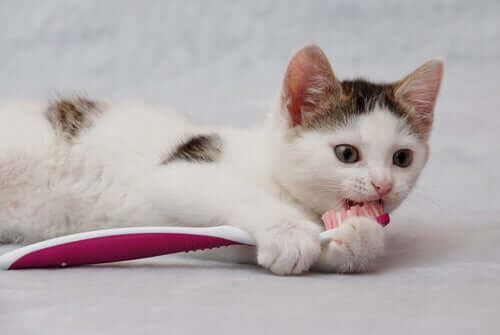Learn How to Brush Your Cat's Teeth!

Although felines are very hygienic and spend all day licking and grooming themselves, there’s one part of their bodies they can’t wash: their teeth. In addition to normal hygiene, it’s essential that, as a pet owner, you make sure to brush your cat’s teeth. Keep reading, because in this article we’ll tell you how!
How to brush your cat’s teeth

Cats need to have clean teeth, as well as clean fur. However, most cat owners don’t know how to do it properly. Poor oral hygiene can not only cause tartar or gum inflammation but can also lead to the aggravation of diseases such as diabetes in adult and elderly cats.
Dental resorption is among the typical ailments in a cat’s mouth. This is an inflammation that happens in the skin tissue and that causes fragility in the teeth which can later fall out. Gingivitis is also a very common ailment. In this case, you’ll be able to notice the redness of the gums and, in many cases, there will be bleeding.
If you notice that a cat has a yellow or black layer on their teeth and emits a very unpleasant smell when they open their mouth, it’s a sign that they need a good clean. According to a study by the American Veterinary Society, 7 out of 10 cats have oral problems due to lack of hygiene.
Since cats don’t know how to brush their teeth on their own, their owners should help them. In addition, you should offer them certain foods to complement their oral hygiene. Some cat food is specifically good to keep their teeth healthy and clean. They need to chew it well so that the food rubs their teeth well and removes tartar or leftovers.
If you offer your cat canned food, it won’t have the same effect if the feline swallows the food without crushing it. Vets recommend to change their diet and pay attention to their habits. Some cat food brands are more advisable for cats with tartar or any other oral problem. They even sell “sweets” designed for such purposes.
Tips for brushing your cat’s teeth

No matter how good a meal or a treat we’re offering our cat is, the animal still needs their teeth to be brushed from time to time. There are specific products on the market, such as aerosols, which act as toothpaste. However, you have to be careful as many cats feel scared when they hear the sound of the spray.
Another option is to buy a liquid antiseptic and use it in low doses to prevent intoxication. You can use gauze to apply it on your cat’s teeth. However, never use human toothpaste! It’s harmful to your pet’s health.
In addition, there are special brushes for cats available that you can insert into your fingers for a more comfortable use that includes short and soft pins. At first, we recommend repeating the cleaning process twice a week. After a couple of weeks, once a week should be okay.
The brushing technique
The brushing technique may need to be practiced several times in order for the animal to allow you to do it. The ideal thing would be to get them used to it from a young age. However, if you’re going to start while the cat is already an adult, it’ll likely take a little more time.
As a first step, wrap the cat’s feet with a soft towel so you don’t get scratched. Then help the cat relax by massaging its head and the bottom of its mouth. If you notice your cat is too tense, try again some other time.
Massage its teeth with clean, dry gauze. Then brush using soft, circular motions. You may not be able to clean all the teeth in one “session”. You’ll have to change sides every time you brush.
It’s essential that you use gentle, slow movements. Cats are often frightened or upset by abruptness or if there’s something they don’t like too much. The idea is that your pet will relate the brushing to a game or a demonstration of love and not an activity that leads to pain or discomfort.